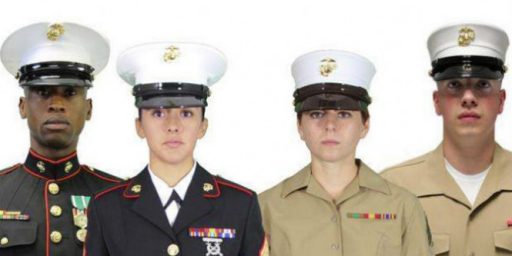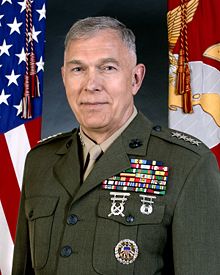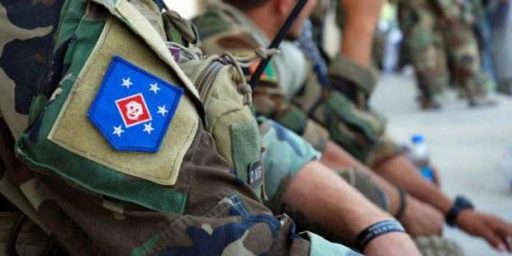An Army Surgeon Says New Helmet Doesn’t Fit Iraq
An Army Surgeon Says New Helmet Doesn’t Fit Iraq (WSJ – $)
Earlier this year, with the insurgency in Iraq building and U.S. casualties mounting, Lt. Col. Jeff Poffenbarger, the Army’s senior neurosurgeon here, became convinced the Army was making a mistake that could lead to American deaths. The Army had begun issuing a new helmet, dubbed the Advanced Combat Helmet. Made of a new type of Kevlar, the helmet is stronger and lighter than its predecessor. But the new helmet has a critical flaw, Col. Poffenbarger contends: It is about 8% smaller than the old helmet, offering less protection on the back and side of the head.
In past wars, this might not have been a big problem. In infantry-style combat, soldiers typically are struck in the front of the head as they charge toward the enemy. But in Iraq, where the deadliest threat is remote-detonated roadside bombs, many soldiers are getting blasted on the sides and back of the head, says Col. Poffenbarger. In other words, they are getting hit in areas where the new helmet offers less coverage. “I’ve become convinced that for this type of guerrilla fight, we are giving away coverage that we need to save lives,” says Col. Poffenbarger, a 42-year-old former Green Beret. This summer, he briefed Gen. George Casey, the top American general in Iraq, as well as a senior Army official in the Pentagon about his concerns regarding the helmet. Gen. Casey declined to comment on the matter. However, a senior defense official said the colonel’s observations are raising questions about whether the Army should move forward with a helmet that may not be suited for the kind of hit-and-run insurgency it is fighting in Iraq. The Marine Corps has already decided not to issue the helmet to the vast majority of its forces.
The questions surrounding the new helmet reflect the broader struggle facing the Army as it tries to transform from a force built to fight traditional armies into one capable of waging guerrilla warfare. Already, the Army is retraining more than 100,000 troops, in specialties such as artillery and air defense, to work as military police, engineers and civil-affairs troops, concentrating on reconstruction. All are considered more effective in battling insurgencies.
Col. Poffenbarger isn’t the only one with doubts about use of the new Army helmet. The Marines have developed their own new helmet, made of the same stronger Kevlar as the Army’s. The Marines decided not to alter the shape, so their new helmet will continue to cover portions of the side and back of the head. The Marines say their helmet provides protection against mortars, remote-detonated roadside bombs and rocket-propelled grenades — three of the biggest killers of U.S. troops in Iraq. “We felt like the extra coverage was needed to protect against those indirect fire threats,” says Lt. Col. Gabe Patricio, the Marine Corps’ project manager for infantry equipment.Col. Poffenbarger’s observations are by no means a comprehensive study. His research is based on about 160 head-trauma patients who have passed through the 31st Combat Support Hospital in Baghdad, where he works. Because the hospital houses the only American neurosurgeons in Iraq, virtually every serious head-trauma patient is treated by him or his partner. “If you get shot in the head in Iraq, I see you,” he says. He has gone through the records of all the hospital’s head-trauma patients, documenting the exact entry point at which the shrapnel or bullet entered the brain and the type of helmet the soldier or Marine was wearing. Extrapolating from this, Col. Poffenbarger estimates the new helmet might result in a 30% increase in serious head traumas if distributed throughout the entire force in Iraq. Because of his research, some senior commanders of new units arriving in Iraq have been given the choice of keeping their old helmets or using the new ones, one defense official says. Tens of thousands of soldiers are already wearing the new helmet in Iraq and Afghanistan.
For now, the Army is committed to issuing the helmet to all 840,000 soldiers in the force by 2007, says Col. John Norwood, the Army’s project manager for soldier equipment. There’s a good reason that the new helmet is slightly smaller, Col. Norwood says. For years, soldiers have complained that when they are lying on their stomachs firing rifles, their body armor rides up — tipping their helmet over their eyes. The new helmet was designed to address that problem. “We think it is a good trade-off or we wouldn’t be fielding it,” he says.
The new helmets — which cost $300 each, compared with about $100 for the old ones — are made to the Army’s specifications by MSA Corp., based in Pittsburgh; Specialty Defense Systems of Dunmore, Pa.; and Gentex Corp., of Carbondale, Pa. Like the Army, the manufacturers say the new helmet allows soldiers to see and hear better than its predecessor. A spokesman for MSA says soldiers are likely to wear the new helmet longer because it is more comfortable. The Marine Corps has bought about 40,000 of its new helmet, which is larger than the Army’s and is also made by Gentex. The Marines plan to buy about 140,000 more over the next two years, at a cost of about $200 each. The Marines also plan on purchasing about 1,000 of the new Army helmets for Force Reconnaissance soldiers, who typically charge out in front of the larger Marine force and are less exposed to shrapnel from artillery and mortars.
Col. Poffenbarger, whose father was an Army physician in Vietnam and whose mother was a geneticist, says that for infantrymen charging into conventional battle, a smaller helmet makes sense. “The best way to be safe in combat is to be more lethal than the enemy,” he says. The new helmet, which allows soldiers to see better while lying on their stomach shooting, should make them more effective in that situation, he says. But for the majority of soldiers in Iraq, who aren’t aiming at the enemy head-on, he contends the new helmet will lead to more injuries and deaths.
The doctor concedes his research has at least two shortcomings. If a soldier is shot or struck by fragment in the head — but is protected by the helmet and avoids serious injury — Col. Poffenbarger is unlikely to see him. “My conclusions could be slightly slanted to the negative because I don’t see the success stories,” he says. He also hasn’t been able to get data on soldiers who are struck in the head and die before reaching the hospital. Col. Poffenbarger estimates there have been 300 such cases since the war began. He has asked the military morgue at Dover Air Force base in Delaware for copies of those autopsy reports but says that so far, officials there have denied his requests to e-mail him the data. A senior defense official said Col. Poffenbarger could review the autopsy data when he returns from Iraq. This official said the request to e-mail data was denied because of concerns the information could circulate and compromise patients’ rights to privacy. “There has been no attempt to keep him from doing research. In fact, we welcome it,” this official said.
Interesting. The obvious–although not cheapest–solution seems to be to have multiple helmets in the inventory. As with most things, one-size-fits-all solutions require compromises. For most applications, the new helmet makes more sense. But if it doesn’t work as well in the Iraqi environment, then commanders should either issue the old helmets or, ideally, have the Marine variant available.






It was hard enough for me to find the regular helmet to fit properly, let alone any new ones that have come along.
At my last unit, there was a 3-unit trade involved among supply sergeants and I still didn’t get the ideal size – had to mess with the screws attaching the green band to the helmet to get it to fit.
At the end of basic at CIF they asked if I was Regular Army; had I been, they would have had me keep my XL helmet and not turn it in.
At least he was thorough in pointing out some of
the flaws in the argument. But the Marines have
a tendency to take care of their infantry a tad
better than the Army. I hate to admit that, but
if variant is made available, I will concede that
the Army cares enough to do right by it’s troops.
An recent article in Strategypage.com reported that the Pentagon was in the process of redesigning the helmet in response to complaints from soldiers and Marines in combat. Their main problem with the old design was that the back of the helmet interfered with the backpack when in the prone position. This made it difficult to raise thair head. This article must be about the new design.
Kinch: Right. The old Kevlar was never popular–it had a number of flaws in comparison with the “steel pot” it replaced. But it’s bulky, odd shape was apparently good for the unique environment of constant car bombings and explosive detonations.
I’m showing my age here, I served wearing the steel pot. While perhaps somewhat less protective of one’s gourd than the Kevlar hats it had one advantage in the long footslogging wars that we may never see again, general utility.
I’ve used that pot to dig and to wash my feet, to cook and to make coffee…hint, before making coffee in a helmet always remember which one everyone washed their feet in the night before. I’ve gathered fruit and eggs and pounded tent stakes, during monsoon season I always filled a helmet or two in case the rain stopped while I was soaped up. During the dry season I took my, pardon the expression, whore baths out of my pot and then shaved with the water that was left. When Doc needed hot water for either the mundane treatment of blisters or the emergency treatment of bad wounds it was ready in seconds by filling a helmet with water and lighting a small piece of C-4. On one bad night a friend of mine lived because he could whip off his pot and beat an NVA Sapper to death with it.
We’ve forgotten the lessons of my father’s war. Take a look at the German POWs, their infantry almost never were wearing helmets because they threw them away on long marches. Our troops never threw their helmets away, they were simply too useful. If we ever get into a foot-soldier’s war again there will be a helluva lot of our soldiers fighting in soft caps.
Something pretty good on your head is far better than something perfect laying in a ditch ten miles back.
They should look at making a hinged or articulated flap that could be attached at the bottom of the helmet.
Boy, this and how the marines combat training has been cut in half, we should pray for them because they’ll need all of the help they can get.